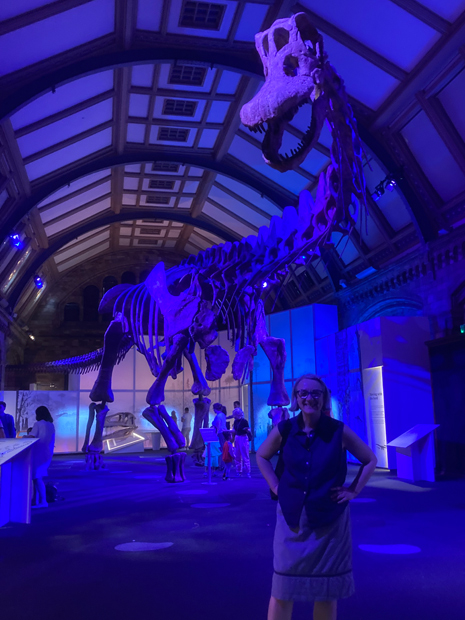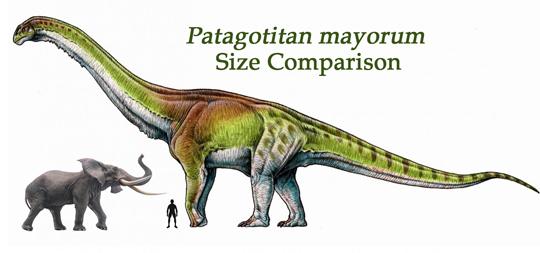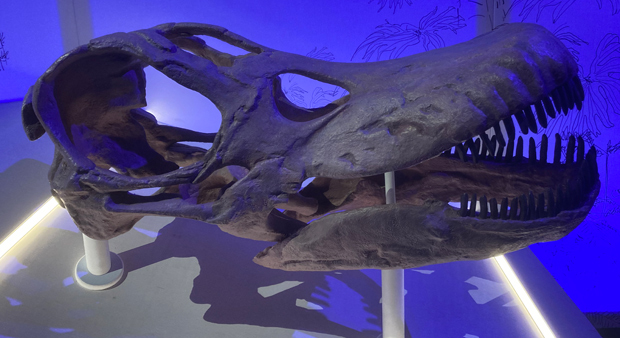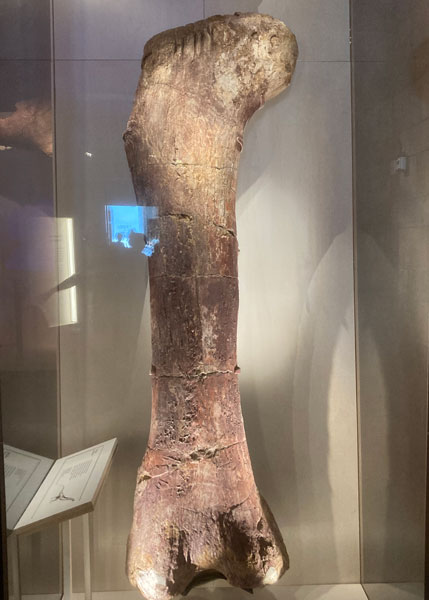A New Giant Dinosaur Gets a Name (Patagotitan mayorum)
Patagotitan mayorum – 69 Tonnes of Titanosaur
This week has seen the long-awaited publication of a scientific paper on the super-sized titanosaur fossils that Everything Dinosaur blogged about in May 2014. Writing in the “Proceedings of the Royal Society B (Biology)”, the researchers, which included José L. Carballido and Diego Pol (Museo Paleontológico Egidio Feruglio, Trelew, Argentina), have described this new dinosaur and given it a formal scientific name. Patagotitan mayorum translates as “the Mayo family Patagonian Titan”.
Patagotitan may already be familiar to readers, as this fossil discovery was documented in a BBC television programme narrated by Sir David Attenborough back in 2016. Indeed, a life-size cast of this dinosaur has been on display at the American Museum of Natural History (New York) for nearly eighteen months.
The Life-size Mounted Exhibit of the Newly Named Titanosaur (Patagotitan mayorum)

Sue from Everything Dinosaur poses in front of the colossal Patagotitan skeleton which is being exhibited at the Natural History Museum (London). Picture credit: Everything Dinosaur.
Picture credit: Everything Dinosaur
Patatotitan mayorum – Size is not Everything
Most of the media sources that have covered this announcement have focused on the estimated weight of Patagotitan. When first studied, the body weight estimate of this beast, (represented by the fossilised remains of at least seven individuals) was put at 77 tonnes. The researchers have down-sized Patagotitan somewhat in the scientific paper, but at a reported 69 tonnes, this is still an immensely heavy beast, potentially close to the theoretical limit for a body weight of a terrestrial animal.
Patagotitan mayorum – A Size Comparison
Picture credit: G. Lio/Everything Dinosaur
With an estimated body length of 37 metres and a weight of 69 tonnes, Patagotitan can lay claim to the title of the largest land living animal to be described to date based on substantially complete fossil remains.
To read an article on the initial excavation of the titanosaur fossil bones: Biggest Dinosaur of all – a New South American Contender.
For an article providing information on the BBC documentary: Attenborough and the Giant Dinosaur.
An Unprecedented Quantity of Titanosaur Fossil Material
The species’ scientific name was inspired by the region where this new species was discovered, Argentina’s Patagonia (Patago); by its strength and huge size (titan), and by the Mayo family, on whose ranch the fossils of this new sauropod species were discovered. The substantial amount of fossil material including a celebrated 2.4-metre-long femur was discovered in three distinct layers, representing flood plain deposits. The researchers have concluded that these large herbivores must have been regular visitors to this area, perhaps this was on a migration route. The water flow was unable to dislodge most of the fossil bones, their sheer bulk allowing the remains to be preserved relatively “in situ”, although in a disarticulated state.
The Life-size Cast of Patagotitan mayorum at the American Museum of Natural History (New York)
Picture credit: Everything Dinosaur
For models and replicas of titanosaurs and other other sauropods: CollectA Deluxe Scale Models.
Estimating the Body Weight of Giant Titanosaurs
The Titanosauria clade represents the most disparate group, in terms of body size of all known sauropods. Some of the smallest members of the Sauropodmorpha are represented by titanosaurs such as the five-metre long Magyarosaurus from Romania, whilst this clade also contains giant animals like Argentinosaurus, Alamosaurus, Dreadnoughtus and the newly described Patagotitan. Calculating the body weight of an extinct animal, even one with numerous fossil bones to study, is a challenging task, body weight has to be inferred using a variety of methods.
Dr José Luis Carballido (Museum of Paleontology Egidio Feruglio) explained:
“We compared the remains of Patagotitan mayorum with all the species that could be related to it, not only in terms of size, but also those that lived at the same time or had certain features in common. Among them we included species such as Argentinosaurus, Puertasaurus and Futalognkosaurus, which are other giant species of dinosaurs from Argentina.”
A Phylogenetic Study
The researchers undertook a phylogenetic study and concluded that the majority of the giant titanosaurs of Patagonia belong to a single lineage. This suggests that gigantism within the Titanosauria evolved only once and not multiple times. The scientists conclude that all the truly huge dinosaurs were related to each other and form a natural group – the Lognkosauria.
Dr Diego Pol added:
“This group of giants probably emerged by the end of the Lower Cretaceous (Patagotitan mayorum would be the oldest) and had survived until the middle Late Cretaceous between 100 and 85 million years ago.”
Patagonia – A Paradise for Titanosaurs such as Patagotitan mayorum
Titanosaurs diversified and radiated around Gondwana during the middle Early Cretaceous and as a group they survived right up to the end of the Cretaceous, but in Patagonia during the early Cenomanian faunal stage some species obtained enormous sizes the reasons for an evolutionary pressure to grow so big are unclear.
Dr Pol commented:
“About 100 million years ago, a subgroup of titanosaurs really went crazy in body size. There must be something in the environment, in how much resources and food was available, in the climate, something must have allowed this fantastic size. All these contenders for the heavyweight championship of dinosaurs, they all lived in same place, in the same time…understanding why and how these animals evolved into such a fantastic size is the million-dollar question.”
The Enormous Fossilised Femur of Patagotitan mayorum
Picture credit: Everything Dinosaur
Links to the Rinconsauria
In addition, the scientists consider this super-sized lineage of titanosaurs a sister group to the Rinconsauria, a clade of titanosaurs also known from Argentina which are regarded as basal to the group, or at least retaining primitive traits. The Rinconsauria, which includes Rinconsaurus caudamirus and Aeolosaurus were not giants themselves, in fact, this clade includes some of the smallest South American titanosaurs described to date.
For the time being the moniker used to describe this huge dinosaur when it was being excavated – “enormosaurus” is redundant, that is until the next huge sauropod fossil find!
The scientific paper: “A New Giant Titanosaur Sheds Light on Body Mass Evolution Among Sauropod Dinosaurs” by José L. Carballido, Diego Pol, Alejandro Otero, Ignacio A. Cerda, Leonardo Salgado, Alberto C. Garrido, Jahandar Ramezani, Néstor R. Cúneo, Javier M. Krause published in “The Proceedings of the Royal Society B”.
Visit the award-winning website of Everything Dinosaur: The Everything Dinosaur Website.




